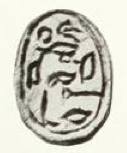Attestations
Yakareb is one of the few attested kings of the 14th Dynasty with two scarab seals attributable to him, both of unknown provenance. [3] [4] One of the two scarabs is currently housed in the Egyptian Museum of Berlin, catalog number 293/73, while the other is in the Petrie Museum, under the catalog number 11810. [3] [5] [6] [7]
Since "Yakareb" is this king's nomen, it is not possible to assert whether or not Yakareb is listed on the Turin canon. The Turin canon is a king list redacted in the early Ramesside period, which serves as the primary historical source for the 14th Dynasty but which records only the prenomen of the kings. Moreover, the document is fragmentary and Yakareb's prenomen may be lost in a lacuna. [4] Thus, Yakareb is attested for certain by only the two scarabs, both of which are crudely made, and it is possible that "Yakareb" is a garbled or variant form of the name of a better known king of this time period. [6]
This page is based on this
Wikipedia article Text is available under the
CC BY-SA 4.0 license; additional terms may apply.
Images, videos and audio are available under their respective licenses.
